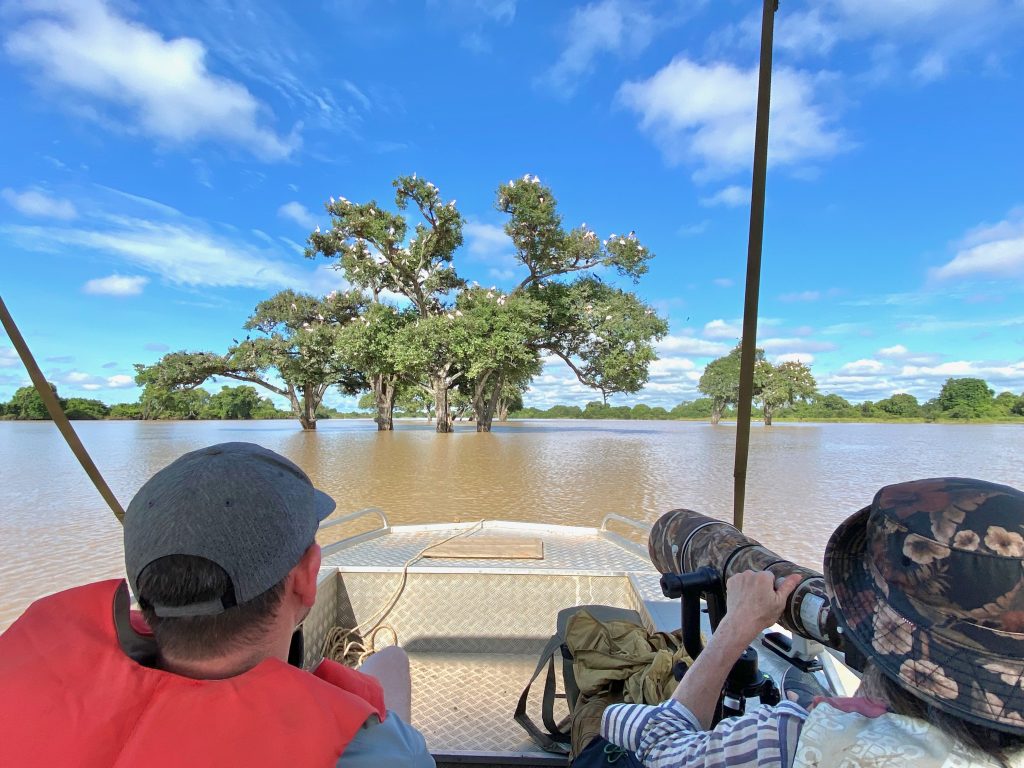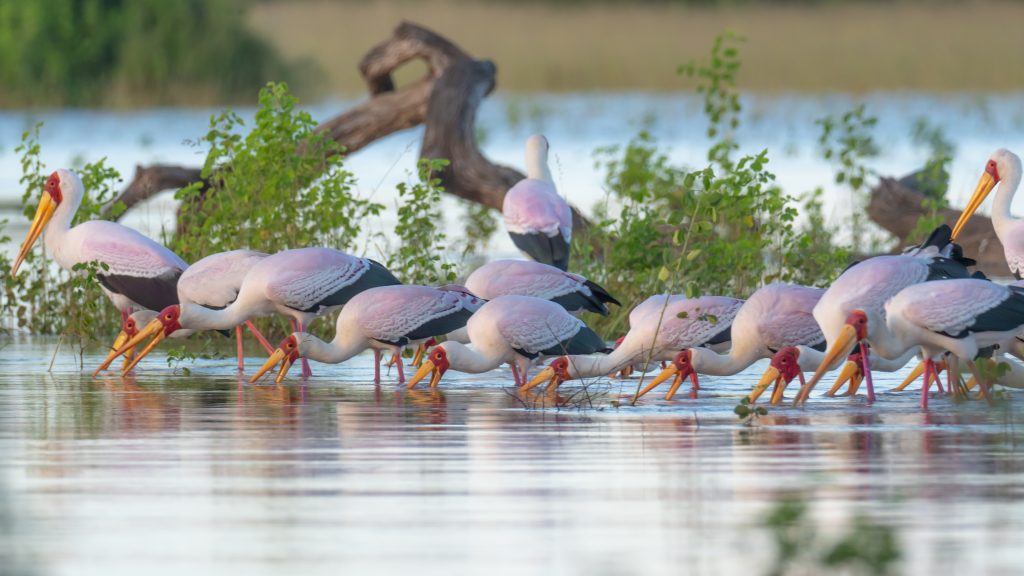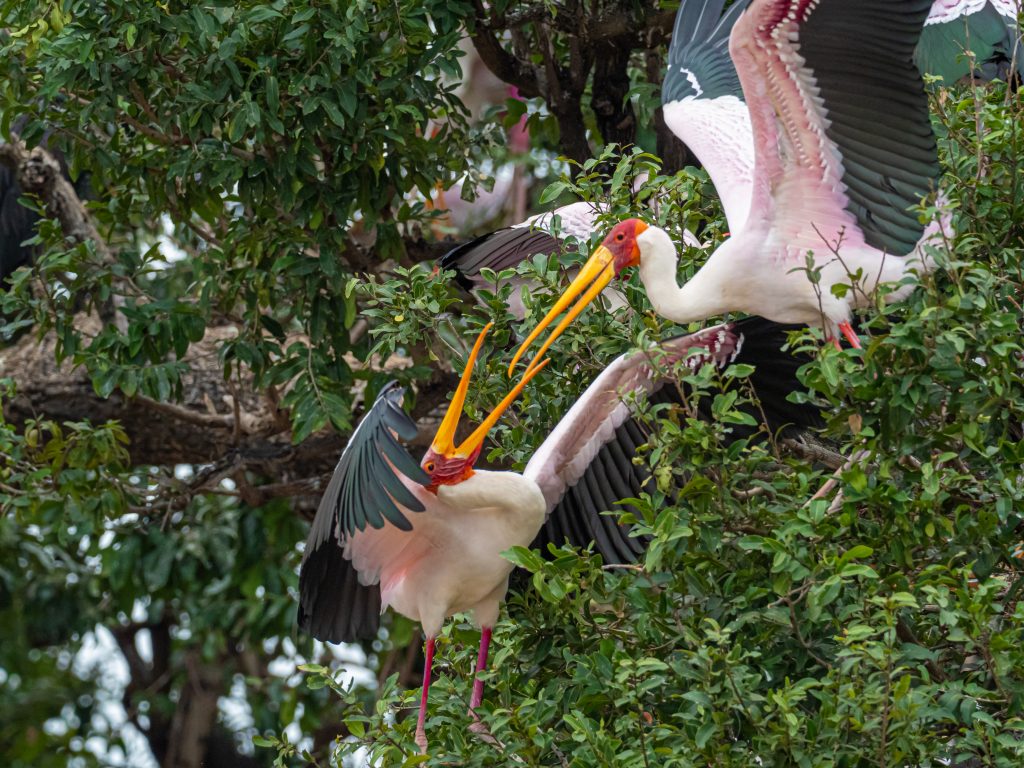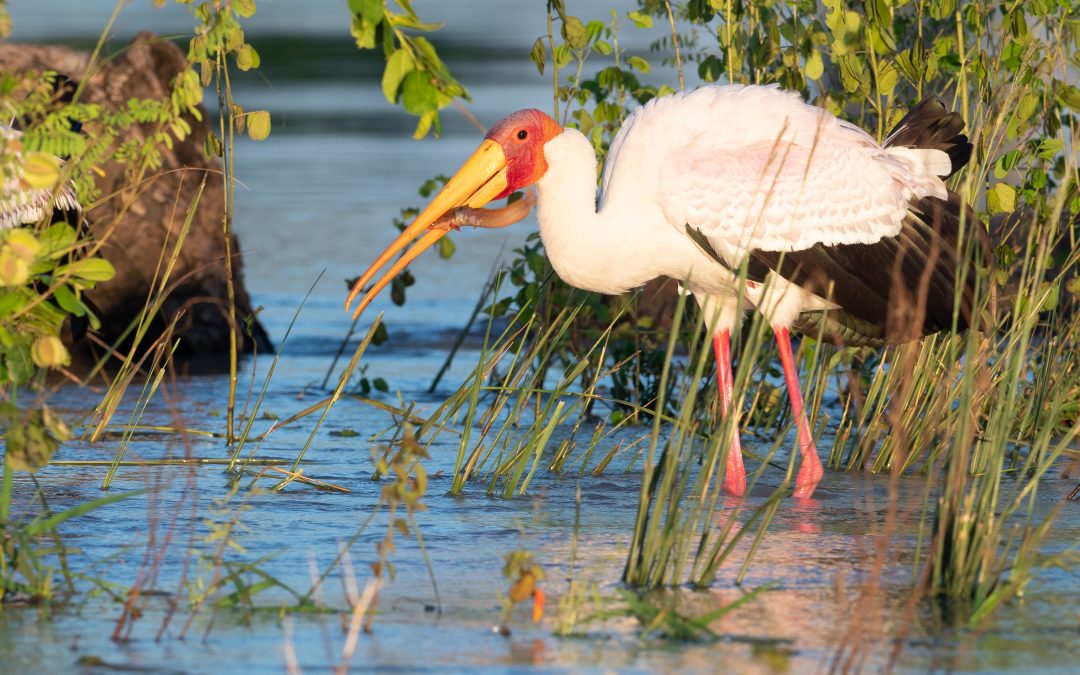The story of the yellow-billed stork in Zambia
Written by Nancy Law – Dazzle Africa Safari Coordinator
We are here in Zambia for a Dazzle Africa Emerald Season safari, a very special time of the year to enjoy the South Luangwa National Park. The Luangwa River and the oxbow lagoons are filled to the brim and spill over into the lush and verdant bush. It’s only during this unique time of year that one can boat through the ebony groves, which provides a safari experience like no other. Our home for 3 nights is the storied Robin Pope Safaris’ Nsefu Camp, the only camp open during this time of year in the remote Nsefu sector of the park. We are the only safari-goers within miles and miles of wilderness ~it’s just us and the wildlife.

Boarding our only means of transportation, a sturdy and capable boat expertly driven by our guide, Willie, we slowly cruise up the river and around trees in channels of water that, during the dry season, will become roads. Shy hippos peer suspiciously at us with eyes just above the water’s surface and then silently disappear. High up on the river bank a bull elephant eats a trunk full of long green grass while puku, kudu and zebra watch us alertly from the shore. As we round a bend of the waterway we become aware of a din in the distance, as if there were some secret baseball game being played far out in the wilderness with the beasts of the bush in attendance. As we cruise further away from the river and deeper into the flooded bush, the racket gets more distinct and louder – falsetto screams, chaotic hisses, a cacophony of baritone “woofing” wing beats accompanied by the clatter of clapping beaks. We soon learn that it’s the “opera” of the breeding colony of the yellow-billed storks.

Year after year the birds come to this spot enmasse, after the rains hundreds of miles upstream have filled the river and bush to the brim and isolated a certain group of jackalberry trees in a prison of life giving protective water. Nesting is synched to this phenomenon each year providing a sanctuary safe from predators below and timed for peak food availability. As we glide closer to the sound of the rookery we see tree after tree impossibly stacked with thousands of yellow billed storks in a free-for-all hive of activity. The birds are all jockeying for the best nesting site and the branches seem like they will break under the strain. Other birds have come too, herons and African open-bills somehow have managed to sandwich themselves amongst the fray.

From the boat, we watch the dance of mating and nest building in fascination – there is so much happening! The yellow-billed storks, male and female, have dressed themselves in breeding plumage all done up in white, pink and green and donned leggings of brightest fuschia. Bills of glowing yellow and faces rouged in deep red completes their courtship costume. It’s the start of an avian ballet that has gone on for centuries.
High up in the tree, a male yellow-billed stork has picked the perfect nest site and is showing it off to a female who has come in to inspect his choice in the bower. Displaying an extensive repertoire of courtship behaviors, he preens – stripping down each of his extended wings with his yellow bill several times on each side, like a bodybuilder displaying his muscles. He picks up twigs from the nests by gently grasping and releasing them at regular intervals to show them off to his potential queen. She in turns stands in a balancing posture, gapes her bill open and inclines her neck upward to the sky… if she passes the test, he invites her into the nest and mating begins. Bill clapping, head shaking, 15 seconds of marital bliss and the nest building begins in earnest – the proverbial stork is on the way!

The ballet continues as storks fly off from the colony to begin a dance of high stepping moves on the shore while searching for the perfect branch or twig to bring back to their waiting nursery mate. He carefully chooses among the detritus, looking for the ideal size and shape with just enough leaves attached, hoping that his choice will impress and be just right. A male yellow-billed has picked up a branch that looks impossibly too large to fly with – but with a run and a hop, he’s airborne and off with his trophy to present to his waiting mate. But, other birds want that prize – it’s just the right size to bring to their mate. There’s a tussle in the air and he’s thrown off course and alas he drops it, only to find others swooping in for the catch. Then there’s the fellow that brings back the smallest of twigs, a lone leaf hangs on as he flies to present his gift to his lady. What must she think? It’s too small, or it’s the crown jewel to complete the cradle and it’s just perfect!
We watch on as the dance continues ~ several yellow-billed storks are lined up in the shallow waters as if in a chorus line. In a coordinated two-step, they stir the bottom with their feet churning up the silt on first one pink foot for a few steps, then the other foot. With partially open bills they probe for fish in the muddy waters and when they finally make contact, there’s a snap of the bill, a raise of the head and dinner is swallowed whole. The storks pay no mind to their audience of crocodiles that lie practically under their noses waiting to snatch up a fish disturbed by their wading waltz. We can’t help but wonder at the closeness of the crocs. What if?

As the earth heats the morning air, we watch as a swirling mass of African open-bills take an intermission from the activity and glide high upward on unseen thermals. Our time with the yellow-billed stork colony is coming to an end and our guide turns our boat for camp as we sit in awe at the avian spectacle that we have been so privileged to behold. Soon the nests will be filled with fluffy white chicks and we wish the birds luck in their rearing and for their continued safety. We know that for now they will be safe in their stick nests, but we have learned that as the water dries up and the trees are no longer protected by the waters below, the predators will come… hyenas, baboons, leopards and others. We hope that by then most of the new birds will have flown off to parts unknown. But they will be back next year to join in the “opera and ballet” in these jackalberry trees to bring in the next generation. Our morning has been so incredibly special – how many people in the world have been lucky enough to witness this secret dance in the bush?
Come on Dazzle Africa’s Emerald Season Safari, 2024 and see for yourself!


